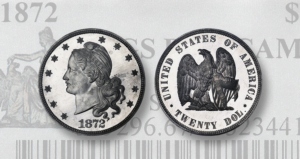The Red Book of US Coins definition says “Experimental or trial coin, generally of a new design denomination or metal.” Collectors know these coins are some of the rarest and most difficult to obtain pieces ever minted. Below is an article from Coin World magazine. The pattern coin featured is from 1872 and struck in aluminum. The Hammer price was an astounding $132,000!
William Barber’s handsome Amazonian design is seen on this Proof 67 Cameo 1872 $20 double eagle pattern struck in aluminum that sold for $132,000 at the post-FUN auctions.
William Barber’s Amazonian design is one of the most famous in the pattern series. Some examples feature a full seated Liberty, while others — like the Judd-1252 1872 $20 double eagle graded Proof 67 Cameo by PCGS that auctioned on Jan.11 — feature just the bust.
Barber produced patterns for all six gold denominations that year, featuring Liberty with a Phrygian cap. Today, one set is known in gold, with two $20 pieces confirmed in aluminum joined by perhaps a dozen copper examples of that denomination.
“It wasn’t until 1886 and the discovery of the electrolytic method of producing aluminum that the metal was easily produced and it became cheaper and more widely used,” and earlier patterns often have laminations and planchet imperfections. This one has several, including a shallow diagonal lamination just above the hair bun, and it sold for $132,000 as part of the Cape Coral Collection, improving on the $114,000 that it sold for at auction September 2020 offering of the Simpson Collection.



 THREE PIECES OF A BALANCED METALS PORTFOLIO
THREE PIECES OF A BALANCED METALS PORTFOLIO